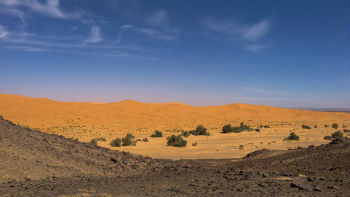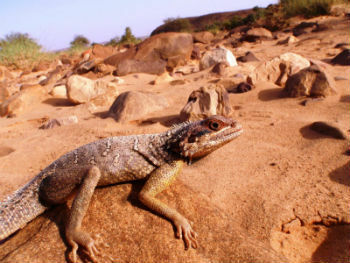The desert corresponds to a type of region in which rainfall does not exceed 250 mm per year. This condition, together with the loss of water through evaporation in the form of steam, makes the region extremely dry.
The temperature range is also extreme, ranging from very hot during the day to very cold at night.
Features
Discover the main characteristics of deserts:
Climate
Deserts occur in places where water loss through evapotranspiration occurs at a rate greater than that normally available to plants.
Temperatures can vary greatly during the day. While the days are hot, with temperatures up to 45 °C, at night it can reach -5 °C. This is because there is little water vapor in the atmosphere and little heat retention. Also, the sandy soil it also does not absorb heat, making the temperature drop in a short time.
Learn more about Desert climate and Air humidity.
hot and cold deserts
However, deserts are not just hot regions, there are also cold deserts.
Hot deserts occur in North America, Australia, Asia and Africa. They have hot, humid periods and some can go for years without rain. Examples include the Sahara and Atacama deserts.
Cold deserts are located in the central region of the continents of Asia and North America. They are characterized by having a cold period during part of the year, when there is rain, in addition to hot summers. One example is the Gobi Desert.
soils

Desert soils are mainly constituted from processes of erosion and are characterized by the presence of minerals and little organic matter, that is, they are not very fertile.
The main compound of this soil is sand, found abundantly in sand sheets and sandbanks.
Rocky soil is also very common and we can still find salt-covered plains from the drying of desert lakes, which are formed by rain or meltwater and are, as a rule, temporary, shallow and savory.
Despite being considered inhospitable, deserts are home to a considerable number of life, which remains hidden in one way or another to preserve its moisture.
Also read about the Soil Types.
Flora and fauna
In general, the vegetation is formed by grasses and shrubs, spread out over the land. Of the desert plants, the most famous is undoubtedly cactus. Xerophilic vegetation is predominant, being that adapted to a dry environment and with adaptations to avoid water loss.
The fauna is not as diverse as in other environments, being basically composed of reptiles, insects and rodents.

It is worth highlighting the oasis, where the vegetation is irrigated by underground sources or artificially, forming places capable of sustaining human life with relative comfort.

Mineral resources
Erosion exposes mineral deposits existing in desert landscapes, which formed, were enriched and preserved thanks to the climate and the water existing in the soil, which leaches (erosion by water) the minerals and deposits them in the groundwater in places susceptible to mining.
Among the most valuable minerals discovered in arid zones, we can highlight copper mining in the deserts of the United States, Chile, Peru and Iran; iron, lead and zinc ores in Australia; gold, silver and uranium in Australia and the United States.
It is also worth remembering that a large part of the Petroleum world is found in arid and semi-arid regions of Africa and the Orient.
desertification
THE desertification of the soil is the process by which deserts are formed, from which vegetation disappears through human or natural action.
Know more about:
- Biomes of the World
- terrestrial ecosystem
What are the biggest deserts in the world?
The largest deserts in the world and their respective areas are:
- Desert of Antarctica (Antarctica) – 14,000,000 km²
- Saara's desert (Africa) – 9,000,000 km²
- Arabian Desert (Asia) – 1,300,000 km²
- gobi desert (Asia) – 1,125,000 km²
- Kalahari Desert (Africa) – 580,000 km²
Curiosities
- Deserts are ideal places for the preservation of human artifacts and fossils, hence the high incidence of mummies and other archaeological discoveries in desert regions.
- Deserts cover approximately 20% of the Earth's surface.
Read too: What is a biome?

